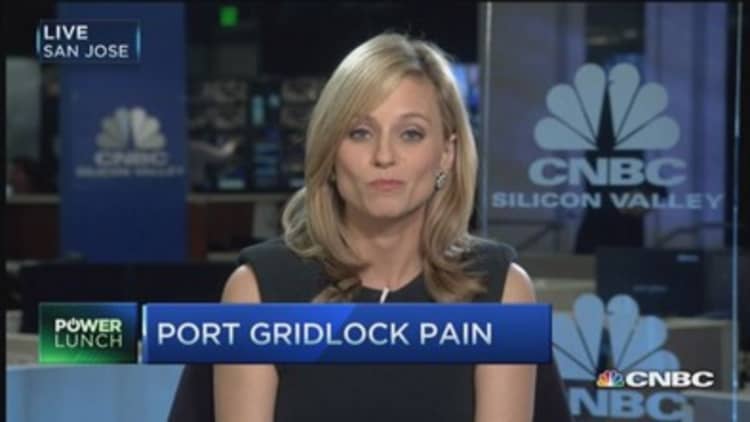
Retailers' anxiety levels are rising as gridlock grinds on with contract negotiations between West Coast dockworkers and port terminal operators.
It has been a long nine months for those dealing directly, or indirectly, with the lack of a West Coast port contract, and after a temporary shutdown over the weekend, retail lobby groups and consultants are assigning potential costs to the issue.
According to a Kurt Salmon analysis, congestion at West Coast ports could cost retailers as much as $7 billion this year. That congestion cost comes from a combination of the higher price of carrying goods and missed sales due to below optimal inventory levels.
A prolonged shutdown of course would be worse—and it would hit more than just the retail community. The National Retail Federation and National Association of Manufacturers estimate a 10-day shutdown could levy a $2.1 billion per day hit to the overall economy as about half of the nation's international imports come into the country via the West Coast ports.
Read MoreCalifornia ports congestion 'worst-ever on record'
Without naming names, Kurt Salmon retail supply chain strategist Frank Layo said a number of retailers have begun to shift shipments to East Coast ports, or are buying extra inventory in advance to mitigate inventory disruption, though those measures are only temporary Band-Aids for a potentially large wound.
The cost to retail could get exponentially worse going forward. Layo said congestion coupled with rate increases from import growth, and retailers could be facing $36.9 billion more in 2016 than 2014's baseline costs.
While retailers are often reluctant to directly discuss supply chain disruption, the topic has become more prevalent in recent retail earnings conference calls. Last week, both Ralph Lauren and Michael Kors executives addressed the issue.
Read MoreLower gas prices no windfall for these retailers
"The port congestion on the West Coast continues to pose a risk to incoming shipments," said Michael Kors CEO John Idol on the company's third-quarter conference call.
"While we have not seen a material financial impact thus far, we have experienced an increase in delays, which are resulting in additional airfreight cost and other transportation fees. While we have factored these increased expenses into our fourth-quarter guidance, there is some risk of additional delays that could result in lower revenues and higher cost than what we have anticipated," he said.
Ralph Lauren CFO Christopher Peterson also explained how the retailer has so far dealt with the West Coast port congestion. "We did have to airfreight more product during the quarter. We also wound up routing a lot of product via water routing, so we shifted around the U.S. and received it in the East Coast ports," Peterson said.
The company's chief operating officer, Jackwyn Nemerov, added the transit time was extended by three to 10 days, though "service levels to customers has been maintained."
FBR Capital Markets retail analyst Susan Anderson said not all retailers have the same exposure to the West Coast ports. In a note to investors, Anderson said "we believe L Brands, Children's Place and Hanesbrand are best-positioned to weather current port congestion, as these companies either rely on airfreight (such as LB) or have advanced planning and logistical capabilities (such as PLCE and HBI)."
Read MoreConsumer is back: Mall titan
On the other hand, she said, "We believe that companies with prior optimistic views of congestion improvement, such as Ascena and Ann Inc. are potentially at a higher risk of additional negative exposure to supply chain disruptions, either though delayed shipments (an impact to sales) or higher-cost airfreight."

When considering which retailers might fare better than others at least in the short run, Layo said, "near-term winners may be fast-fashion retailers who have built the cost of airfreight into their margin structure. Over time though, expect them to face increased air rates as others need emergency capacity."
Examples of fast-fashion retailers include Forever 21, Sweden's H&M, Zara (owned by Spain's Inditex) and Britain's TopShop.
Even if negotiations lead to a quick resolution from here, normal operations are still months away because of the backlog so far. Anderson said it may even take the bulk of 2015 for shipments to normalize.
Longer term, the continued strain at West Coast ports could have other effects, including the possibility of increased U.S. manufacturing—a trend that has recently become a hot topic as the economic equation comes more in line with costs of overseas production rising, according to Layo.
He also thinks retailers can only absorb the higher costs associated with rerouting shipments for so long.
"We're expecting [considerably higher costs] to hit retailers in calendar year 2016 in a major way, and I would expect that would result in higher costs for consumers by the end of next year," Layo said.
But it is clear the industry is getting frustrated. NRF, its trade group, issued a harshly worded statement, saying in part: "Enough is enough. The escalating rhetoric, the threats, the dueling press releases and the inability to find common ground between the two sides are simply driving up the cost of products, jeopardizing American jobs and threatening the long-term viability of businesses large and small."


